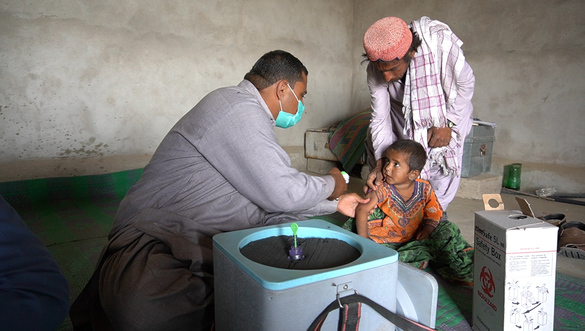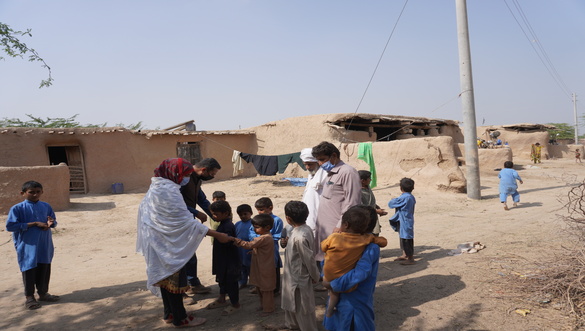
A young boy from a small remote village in Rajanpur gets the new polio vaccine.
Punjab, Pakistan– It’s the final day of a special 10-day polio campaign. Health workers have arrived in a remote village in Punjab’s most under-privileged district – Rajanpur. The team sets up a temporary vaccination site in a small hut usually reserved for guests. But by late afternoon, the team becomes concerned – 24 children who were scheduled to be vaccinated have not turned up.
The team’s two social mobilisers try to find out what happened.
“We weren’t sure why the children didn’t come. The parents had been informed about the visit today and the location of the vaccination site," said Majida Bibi, lead social mobiliser in the area.
“After talking to some neighbours, we found out one family was away at their grandmother’s house in another village. We weren’t sure why, so we needed to check if the parents had any concerns about the polio vaccination," says Majida Bibi, the lead social mobiliser in the area.
Later in the day, Majida and her colleague return to the vaccination site with five children in tow. But as they enter the hut, some of the children begin to cry. They don't see the regular polio drops they usually receive by mouth (OPV). This time, they see an injection device that will deliver IPV (inactivated polio vaccine)
“But the children look surprised when they realise it doesn't hurt because we are using the new jet injector, which is painless.”, said the vaccinator.
Giving children added protection

Social mobilisers bring children to a makeshift vaccination post in Dera Ghazi Khan, Punjab.
IPV was introduced in Pakistan several years ago, but this is the first time it has been used in this remote area, and it came just in time.
The campaign was put on hold in March due to COVID-19, but this raised concerns that the polio virus could once again spread across vulnerable populations. The government then decided to go ahead with the campaign in the most impoverished areas of DG Khan, Rajanpur, and Lahore.
Introducing IPV has its challenges. Parents and caregivers have been used to their children receiving the drops. Some parents questioned how effective injectable polio vaccines are, and others were worried their children would experience side effects.
“The public associates injectable vaccines as being painful and with side effects including redness or fever. Some parents also ask about the significance of the IPV when polio drops are also being administered”, said Mr Abu Bakr, who is in charge of the campaign in the local union council.
Polio vaccines have reduced the incidence of polio by more than 99% worldwide. New evidence clearly demonstrates that adding one dose of IPV to OPV is the most effective method to stop the virus and protect children from lifelong polio paralysis.
When OPV is given to a child, that child develops immunity in the gut (intestines), which is required to stop the person-to-person spread of the virus. While IPV develops immunity in the blood. This means that not only is a child is better protected from the polio virus, but they are less infectious.
“The fractional dose of the IPV in this campaign will help boost the immunity of children most-at-risk against the polio virus. This is an effort to stop polio transmission in Pakistan”, says Ms Sundas Irshad, head of the polio programme in Punjab.
“IPV and OPV are completely safe and very effective. It is in the best interests of the child to receive both polio vaccines and all vaccinations and health services", she added.
Out of the 26 polio cases reported in 2019-2020, seven have been in Lahore, nine in DG Khan and one in Rajanpur. The virus has also been detected in almost all polio environment sampling sites.
Never Stop
As per data available, the polio programme achieved more than 100 per cent coverage during the 10-day campaign. Over 630,000 children received the polio vaccine in Lahore, while over 160,000 were vaccinated In DG Khan and 110,000 in Rajanpur.
“The implementation of the campaign was a major success”, declared Ms Sundas Irshad, head of the Punjab Polio programme.
“The high coverage in the campaign will help build immunity and protect the targeted children against the crippling virus”, she added.
Global efforts to end polio continue despite the pandemic, especially in Pakistan and Afghanistan, the last two polio-endemic countries. The goal is a world free of polio, and data shows we are getting closer – from some 400,000 cases globally in 1980 to less than 150 in these two countries. That's why reaching every child in every remote corner is critical to achieving that goal.
Ismail Leghari, is a Communication Officer, Polio in Rajanpur. He works with the district health management team to mobilise communities against this paralysing disease. Additional reporting for the piece has been done by Communication Officer Polio DG Khan, Kalim Tahir, with the support of the EOC communication team in Lahore.
---------
